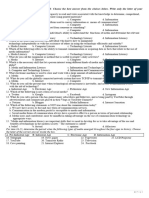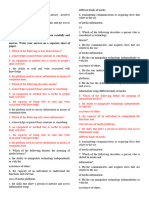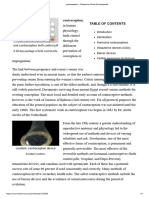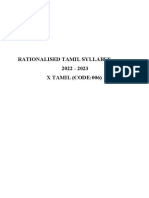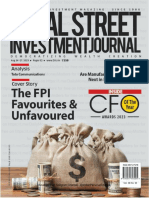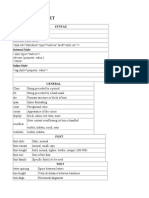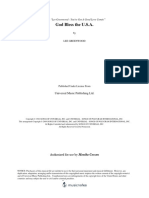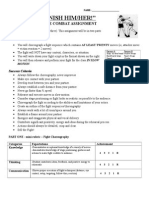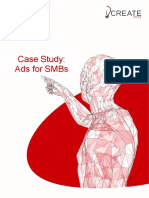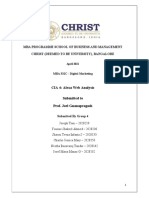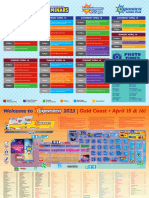BETINAN NATIONAL HIGH SCHOOL
Betinan, San Miguel Zamboanga del Sur
School Year: 2024-2025
FIRST QUARTER EXAM
Media and Information Literacy
Name: ______________________________ Grade and Section: ________________
PART I. FILL IN THE BLANKS. Read each question and give what is asked. You may give a
‘term’ or ‘a phrase’. Write your answer in the space provided before each line. The terms or
phrases can be found in the word bank provided.
__________1. The main means of mass communication such as broadcasting, publishing and
the Internet.
___________2. The ability to access and analyze media messages as well as create, reflect
and
take action, using the power of information and communication to make a
difference in the world.
__________3. It determines how content is filtered, ranked, selected, and recommended to
users.
__________4. It refers to the facts presented in a particular article.
__________5. It is the ability to find, evaluate, organize, use, and communicate information in
all
its various formats.
__________6. It refers to the knowledge and skills required to effectively and responsibly use
technology tools and resources.
__________7. It refers to any form of communication before the advent of the Internet.
__________8. It refers to the process by which inaccurate information is unintentionally spread.
__________9. It refers to the use of inaccurate information that was spread deliberately.
__________10. It refers to the process by which two individuals engage in exchanging
information.
WORD BANK
Media Communication Media Literacy Algorithm
Disinformation Misinformation Traditional Media
Technological Literate Information
Information literacy
Part II. MULTIPLE CHOICE. Read the question carefully. Write your answer in the space provided.
___1. Which of the following is NOT a way the internet has transformed communication?
a. Increased real-time, global connectivity
b. Enabled asynchronous interactions
c. Reduced opportunities for in-person interactions
d. Provided more avenues for self-expression
___2. Which of the following is a positive impact of the rise of social media on interpersonal
communication?
a. Increased meaningful face-to-face interactions
b. Facilitated the spread of misinformation
c. Fostered a sense of community and belonging
d. Reduced the importance of nonverbal cues
___3. Which of these is NOT a key way that advancements in mobile technology have changed how
people stay connected?
a. Enabled constant access to information and communication
b. Reduced reliance on physical face-to-face meetings
c. Provided more opportunities for multi-tasking
d. Decreased the use of email and text messaging
___4. Which of the following is a way the transition from print to digital media has altered news
consumption?
� a. Increased the depth and nuance of news coverage
b. Reduced the speed at which news is disseminated
c. Empowered readers to be more passive consumers
d. Allowed for more personalized, targeted news delivery
___5. Which of the following is a potential danger of algorithms and personalized content?
a. Increased exposure to diverse perspectives
b. Reinforcing existing biases and echo chambers
c. Promoting healthy digital habits
d. Encouraging critical evaluation of information
___6. Which of these is NOT a recommended strategy for maintaining healthy communication habits in
the digital age?
a. Limiting screen time and multitasking
b. Prioritizing in-person social interactions
c. Uncritically trusting content from online sources
d. Developing media literacy skills
___7. Which of the following is a way that cultural differences and language barriers can be worsened
through communication technologies?
a. Increased opportunities for translation and interpretation
b. Amplification of misunderstandings and miscommunications
c. Improved cross-cultural exchange and mutual understanding
d. Reduced need for face-to-face, contextual interactions
___8. Which of the following is NOT an effective way to combat the spread of misinformation and "fake
news"?
a. Promoting media literacy and critical thinking
b. Relying solely on authoritative and verified sources
c. Engaging in productive, fact-based discourse
d. Passively consuming and sharing content without verification
___9. Which future advancement is most likely to dramatically transform human communication and
interpersonal interaction?
a. Improved video conferencing software
b. Increased adoption of virtual and augmented reality
c. Advancements in mobile phone battery life
d. Expanded use of emoji and GIFs
___10. Which of the following is a primary focus of media literacy?
a. Evaluating the credibility and reliability of information sources
b. Understanding how to effectively use digital technologies
c. Analyzing the messages, biases, and effects of media
d. Developing proficiency in using productivity software
___11. A key distinction between information literacy and technology literacy is that information literacy
primarily focuses on:
a. Evaluating the accuracy and purpose of information
b. Navigating and troubleshooting digital devices
c. Creating and publishing multimedia content
d. Mastering the technical features of computer hardware
�___12. Which of these skills is most closely associated with technology literacy?
a. Identifying trustworthy online references
b. Interpreting data visualizations and infographics
c. Customizing software settings and preferences
d. Discerning fact from opinion in news articles
___13. All of the following are important for developing media literacy EXCEPT:
a. Understanding the commercial and political interests that shape media
b. Analyzing how media messages influence attitudes, beliefs, and behaviors
c. Passively consuming diverse types of media without critical reflection
d. Recognizing stereotypes, biases, and omissions in media representations
___14. An individual who is highly information literate would be skilled at which of these tasks?
a. Optimizing a website's search engine visibility
b. Protecting personal data and online privacy
c. Locating, evaluating, and effectively using information
d. Troubleshooting hardware and software malfunctions
___15. Which literacy type is most directly concerned with the technical operation and functionality of
digital technologies?
a. Media literacy
b. Information literacy
c. Technology literacy
d. Digital citizenship
___16. All of the following are areas of overlap between media literacy, information literacy, and
technology literacy EXCEPT:
a. Evaluating the credibility of online sources
b. Developing proficiency with productivity software
c. Recognizing the impact of social media algorithms
d. Applying ethical principles to digital interactions
___17. A digitally literate student would be able to demonstrate which of these abilities?
a. Quickly learning new software applications
b. Identifying misleading or false information online
c. Analyzing the narrative techniques used in films
d. All of the above
___18. Compared to information literacy, technology literacy places greater emphasis on:
a. Analyzing information and digital media critically
b. Applying digital tools to research and communication
c. Developing technical fluency and problem-solving skills
d. Navigating the societal and ethical implications of technology
___19. Which literacy type is most focused on understanding the motivations, business models, and
societal impacts of media platforms and content creators?
a. Media literacy
b. Information literacy
c. Technology literacy
d. Digital citizenship
___20. Which of the following is the primary goal of media literacy education?
a. Teaching students to use digital technologies proficiently
b. Developing critical analysis skills to navigate media messages
c. Promoting the consumption of diverse media content
d. Ensuring students have access to the latest communication technologies
___21. Which of the following media habits is MOST closely linked to increased levels of anxiety,
depression, and low self-esteem among teenagers?
a. Frequent use of social media for creative self-expression
b. Regular participation in online communities and forums
c. Excessive time spent scrolling through curated social feeds
d. Engagement with educational and informational content online
___22. Compared to their parent's generation, teenagers today are more likely to:
a. Prioritize offline, in-person social activities over digital interactions
b. Demonstrate greater digital literacy and technology problem-solving skills
c. Exhibit a stronger preference for long-form, text-based media consumption
d. Maintain a clear separation between their online and offline identities
___23. Which of the following is a key benefit of developing technology literacy skills?
� a. Increased opportunities for creative self-expression
b. Reduced vulnerability to online privacy and security threats
c. Greater trust in the objectivity of algorithmically-curated content
d. Avoidance of potential ethical dilemmas posed by new technologies
___24. A teenager who prefers getting news and information from social media platforms over traditional
news sources is more likely to:
a. Develop a nuanced, well-rounded understanding of current events
b. Be exposed to a diverse range of perspectives on important issues
c. Form beliefs and opinions that are heavily influenced by algorithms
d. Demonstrate strong critical thinking and fact-checking abilities
___25. High schoolers who frequently engage in online multiplayer gaming are more likely to:
a. Struggle with maintaining healthy face-to-face relationships
b. Develop strong collaboration and strategic problem-solving skills
c. Spend less time on their academic responsibilities and hobbies
d. Both a and c
“The beautiful thing about learning is that no one can take it away from
you." Arnonymous!
Good Luck and God Bless!












